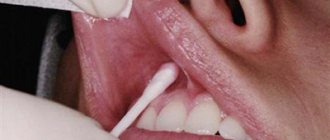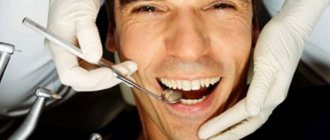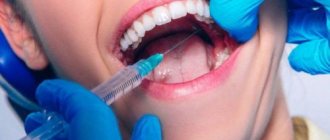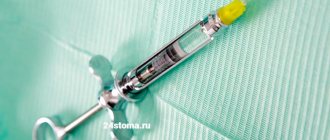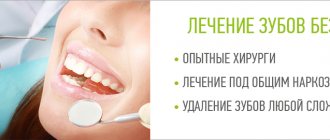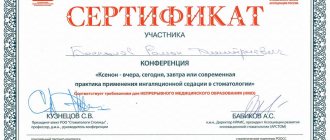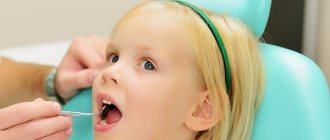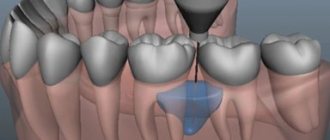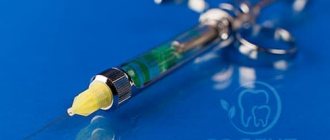Almost every adult whose childhood occurred at the end of the twentieth century has painful memories of visits to the dentist. For some, this has led to chronic neurosis, which occurs just at the thought of dental treatment. However, children living today do not have to endure the same difficulties. Modern dental clinics use the most effective methods of pain relief, including treatment during sleep, when the patient does not feel pain at all and does not even remember the procedure.
Content:
- Features of the use of anesthesia in pediatric dentistry
- Types of anesthesia in pediatric dentistry
- Local
- General
When treating primary teeth, dentists use different types of anesthesia. Thanks to anesthetics, even complex medical procedures are as comfortable as possible for a small patient. Therefore, parents do not need to worry - if they contact an experienced and responsible doctor, the child will undergo all the necessary procedures very easily.
General anesthesia
Anesthesia is used in pediatric practice, but the procedure is performed only by an anesthesiologist with a preliminary examination of the child and the exclusion of contraindications. Anesthesia depresses the nervous system and can cause side effects, so it is used strictly according to indications and under medical supervision. The anesthesiologist must be highly qualified, since it is more difficult to calculate the exact dosage for a child than for an adult.
Types of anesthesia for treating children
In dentistry, two methods of general anesthesia are used:
Inhalation. A mask is put on the child and an anesthetic is given. After just a few breaths, he falls into a medicated sleep. This method is more gentle, since the dosage is easier to control during the process, and side effects are rare. Sevoran is considered the most effective and safe mask preparation today.
Intravenous. For young children, an intravenous catheter is installed and Diprivan or its analogues are administered. The dosage of the drug and the duration of drug-induced sleep are established by the anesthesiologist-resuscitator. Treatment must be coordinated with parents or other guardians.
How to prepare your baby for anesthesia
Preparing a child for treatment under anesthesia is a mandatory condition that should never be neglected. You will first need to undergo a series of tests, undergo an ECG, visit a therapist and other doctors (as directed) to obtain permission for general anesthesia. It is necessary to protect your child from colds, since if an infection develops, the date of the procedure will be postponed until complete recovery.
On the day of treatment, food is prohibited for at least six hours, and drinking for four hours. It is important to make sure that the baby does not eat anything behind his back, try to distract him, for example, with a walk, reading a book, etc. The day before, you need to feed the child light but nutritious food.
Indications and contraindications for the procedure
Traumatic dental procedures may require general anesthesia, but this decision depends not on the parents, but on the anesthesiologist.
In what cases is anesthesia justified or even necessary:
- complex operation, large amount of work;
- children under three years of age;
- allergy to local anesthetics;
- low pain threshold;
- Dentophobia (dentophobia) - insurmountable fear;
- pronounced gag reflex;
- a number of neurological or mental diseases.
The use of anesthesia is prohibited during periods of acute respiratory infections, in case of any infectious or inflammatory diseases of the respiratory tract, heart failure, heart defects, underweight, allergies to the drugs used.
Advantages and disadvantages
Treatment with anesthesia has many advantages:
- there is no psychological trauma, since the little patient falls asleep before the operation, and after waking up does not remember anything;
- absolutely painless;
- the doctor is focused on the procedure and is not distracted by the baby, which means medical errors are excluded;
- You can perform a large amount of work, including procedures of any complexity.
The disadvantages include the introduction of serious general medications into the body, which can cause negative reactions. After the procedure, the child remains lethargic for 6–8 hours and requires increased attention from medical staff and parents.
Is it dangerous to treat a child’s teeth under anesthesia?
General anesthesia in pediatric dentistry is not a whim of parents, but sometimes the only possible method of anesthesia. Temporary, as well as permanent teeth, must be treated, since infection and inflammatory processes in the oral cavity deplete the immune system, and premature loss of teeth leads to malocclusion. According to the law of the Russian Federation and a number of other countries, children under three years of age receive dental services only under anesthesia.
General anesthesia has long been safe, as it is carried out using non-toxic drugs, under the supervision of an anesthesiologist-resuscitator and modern equipment. If a child is forced into a chair and treated, the harm will be more significant than the possible side effects. Sometimes after the procedures, children begin to suffer from enuresis, stuttering, dental phobia and other disorders.
Features of the use of anesthesia in pediatric dentistry
In pediatric dentistry, the use of anesthetic drugs is of primary importance. This is due to the fact that adults react more adequately to the doctor’s actions and are usually ready to endure minor pain and some discomfort.
Children do not agree to this. As soon as they feel even slight pain, trust in the doctor disappears. After this, it is difficult to persuade the child to continue treatment. Therefore, anesthesia is very important. It provides physical and psychological comfort.
It should be borne in mind that most anesthetics can only be used when providing medical services to children over four years of age. This complicates the situation somewhat. Therefore, parents should carefully monitor how the baby maintains oral hygiene and help him brush his teeth.
Sedation is an alternative to general anesthesia
If anesthesia is contraindicated or inappropriate, but the child cannot be persuaded to undergo dental treatment, then sedation is used. It comes in two types: inhalation with nitrous oxide or intravenous with Propofol or Dexdor.
In the first case, the child inhales the vapors of “laughing gas” and relaxes, plunging into a pleasant state of half-asleep. He remains conscious and can hear and comply with the doctor's requests. This does not exclude local anesthesia. Nitrous oxide is harmless to the body. Its effect begins immediately after the gas is supplied and stops just as quickly. The procedure is performed on babies, older children and even adults.
Intravenous sedation can be superficial, moderate, or deep. This depends on the dosage of the drug. After the drug is administered, the child’s consciousness is not suppressed, as with anesthesia, but he does not respond to treatment, as he sleeps.
Types of anesthesia in pediatric dentistry
Conventionally, pain relief used in dental treatment in children is classified into:
- Local. It is the most common in pediatric dental practice. It is carried out in two stages. First, the dentist applies an anesthetic gel to the gums, and only then gives an injection. If you exclude the use of the gel, the child will feel pain during the administration of the anesthetic.
- General. It is the only way to cure serious dental diseases in children. Such anesthesia is not used unless absolutely necessary, since general drugs put a strain on the heart and central nervous system and can cause allergic reactions.
- Sedation. An oxygen mask is placed on the child’s face and asked to inhale a soothing mixture. The baby continues to be conscious, but becomes as relaxed and calm as possible. His pain sensitivity threshold increases. Sedation is often combined with an injection of anesthetic.
Answers to parents' questions
- In what cases can teeth be treated without anesthesia? At the Family Dentist, 35–40% of regular small patients manage without pain relief. A child does not need dental anesthesia when treating superficial caries as long as the defects are within the enamel. Without an anesthetic injection, fluoridation and fissure sealing are performed.
- Is it possible to replace the injection with anesthetic gel? No. Application anesthesia (applying ointment to the mucous membrane) has a shallow depth and short-term effect. There is not sufficient pain relief for the treatment of caries and pulpitis.
- Is anesthesia necessary when treating baby teeth? Some parents believe that primary teeth do not have nerves. The pulp of a baby tooth is also penetrated by nerve fibers. But unlike permanent dental units, it occupies more space and is protected by a thinner layer of dentin and enamel. The carious process quickly reaches the nerve; pulpitis may be hidden under a small hole. Dental anesthesia for children helps perform painful and frightening procedures without stress for the little patient.
- Can anesthetics trigger a severe allergic reaction? We use local anesthetics with low allergenic properties. Hives, redness and burning at the injection site, swelling of the mucous membrane can occur in children with hypersensitivity to medications, food components, animal hair, and pollen. To exclude the development of allergies, we recommend doing allergy tests before treatment.
- Does dental anesthesia cause harm to a child? In Minsk and Belarus, tested drugs with low toxicity are used. They quickly disintegrate and are excreted from the body. The potential risk of local anesthesia is less than decaying teeth, inflammation of the root and basal tissues, fistulas, and inflammation of the periosteum.
Do not put off visiting the dentist because you are afraid your child will be in pain. Make an appointment with our pediatric dentists for painless treatment. We will cure your teeth without unpleasant impressions, stress and tears.
Local
Since pediatric dentists use local anesthesia most often, we will dwell on it in more detail. This method gives a good analgesic effect, but does not make the treated area completely insensitive. Has a small number of contraindications.
Effective local anesthesia options:
- Applique. The weakest in terms of the severity of the resulting analgesic effect. An anesthetic gel is applied to the gums (most often it includes lidocaine). The active compounds of the drug quickly penetrate the tissues and dull their sensitivity. The application helps to numb the injection site. It is also sufficient if you have to remove a very loose baby tooth.
- Injection. The most popular medications in the field of pediatric dentistry are those containing articaine. They are injected into the gums using a syringe. This remedy is much stronger than novocaine, but has fewer side effects. It can be used from the age of four. Doctors use conduction and infiltration injection anesthesia - the choice of technique depends on the characteristics of the disease. In the first case, the injection is made in the branch of the trigeminal nerve, in the second - in the border of the transitional fold and the alveolar process. Conduction anesthesia can only be performed on patients over six years of age.
Coming out of anesthesia
Upon completion of treatment, the anesthesiologist reduces the volume of the sedative drug, and after 10-15 minutes the child wakes up. For the first two hours, the patient is instructed to remain in the clinic under the supervision of doctors. The baby spends this time in a specially prepared room with his parents. Rare side effects - nausea, dizziness, pain at the treatment site - are monitored by doctors and eliminated gently and immediately. Then the child is sent home.
You can eat and drink within the time allowed by the treating dentist - after 1-4 hours. There are no other restrictions.
Anesthesia is prescribed only when indicated. Alternative relaxing options include treatment under sedation or local anesthesia. There is no need to be afraid of anesthesia. Medication-induced sleep – peace of mind for parents and comfort for the child. In some cases, it is more useful for a young patient to undergo all manipulations in his sleep.
General
Many parents are so worried about their baby that they want all his teeth to be treated under general anesthesia. This approach to therapy is fundamentally wrong. There are strict indications for such treatment. Among them:
- There is a very large amount of work ahead when the child will have to spend more than one hour in the dental chair. This is possible if many teeth are neglected and you need to cure them all at once.
- Intolerance to anesthetics for local anesthesia. It's rare, but still possible. If the baby is allergic and cannot be given any of the available drugs for local anesthesia, anesthesia is used.
- Insufficient effectiveness of the administered local anesthesia. If the case is advanced and the injection given does not reduce the sensitivity of the treated area to the required level, a more serious option for pain relief is used.
- Phobia. Some children are so afraid of doctors that they faint when they see them or go into a state of panic. The doctor cannot even examine their oral cavity. Of course, you can hold the baby with six or eight hands and force open his mouth. But then he will receive serious psychological trauma. It will be difficult for a doctor to work in such an environment. Therefore, it is much more reasonable to use general anesthesia.
- Cerebral palsy, epilepsy, Down syndrome, some mental disorders. All of these are conditions in which the child behaves inappropriately or cannot control his movements. To relax the patient and ensure complete rest, a general anesthetic is used.
In order for a child to have a good attitude towards dentists and to cross the threshold of a dental clinic without fear, he needs to be taught to take care of his teeth from early childhood. First visits to the doctor can take place in the form of a game. And it’s good if a small patient has “his own” doctor whom he trusts.
Preparation for general dental anesthesia
When the decision is made to treat teeth under anesthesia, the doctor informs the parents about the sequence of preparation:
- examination - taking tests (urine, blood), ECG when indicated;
- adherence to the diet on the day of treatment - refusal to eat 6 hours and drink 2 hours before mask anesthesia;
- taking certain medications before treatment - usually a sedative before bedtime the night before treatment.
A separate stage is emotional preparation. It is not always necessary to inform your child about an upcoming event. By agreement of doctors and parents, the baby can be put into a state of sleep unnoticed, in a playful way. This requires good psychological preparation from the doctor, but the degree of trauma from the treatment and preparatory stages is zero.
